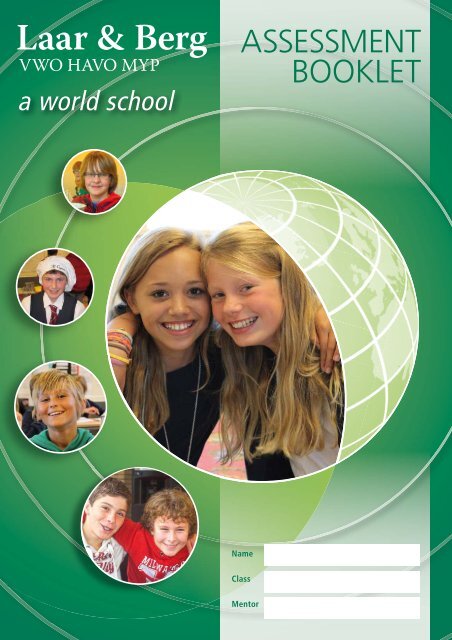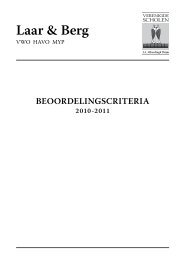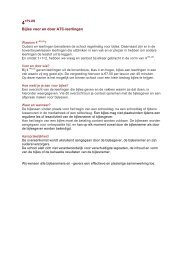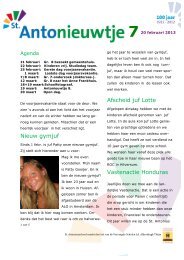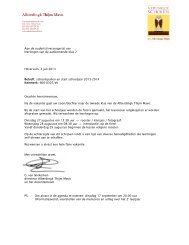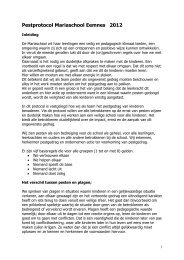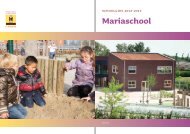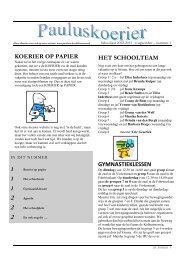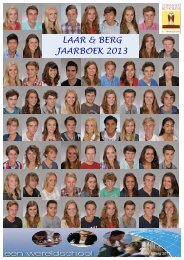Laar & Berg
Laar & Berg
Laar & Berg
You also want an ePaper? Increase the reach of your titles
YUMPU automatically turns print PDFs into web optimized ePapers that Google loves.
<strong>Laar</strong> & <strong>Berg</strong>VWO HAVO MYPa world schoolASSESSMENTBOOKLETnameClassMentor
<strong>Laar</strong> & <strong>Berg</strong>VWO HAVO MYPASSESSMENT BOOKLETMIDDLE YEARS PROGRAMME2012-2013laar & berg Assessment booklet Middle Years Programme 3
IntroductionAs an MYP school <strong>Laar</strong> & <strong>Berg</strong> has developedassessment procedures and methods thatreflect the philosophy of the IB Middle YearsProgramme which can be found in thisbooklet. It contains information about subjectspecific criteria and grade boundaries and willbe of use in understanding the assessmentand reporting system.<strong>Laar</strong> & <strong>Berg</strong>’s MYP assessment policy:• Assessment is always carried out againstdefined assessment criteria and is notnormative;• Assessment criteria are communicatedto students at least one week before theassessment takes place;• The purpose of assessment is always toidentify strengths and weaknesses of thestudents;• Variation is required in assessment tasks and· takes place at all stages of learning· covers all MYP subject criteria· takes different learning styles of studentsinto account· uses a variety of assessment tasks;• Formative assessment is used to regularlyjudge the effectiveness of both the teachingand learning process;• Summative assessment aims to determinethe level of achievement based on subjectspecific criteria;· Every criterion for each subject is assessedat least twice a year.· Levels of achievement will be awarded persubject-specific criterion using the ‘best fit’method.· The levels of achievement per criterionare added up to determine a final overallachievement on 1-7 scale by applying thegrade boundaries of each specific subject.• All awarded levels of achievement shouldreflect ‘ability’. This means that a latepenalty,or not completed work should notbe part of the levels awarded;• All assessments results are recorded inMagister and in the students’ portfolio;• Portfolio’s are taken home by the studentduring Christmas break, spring break, Maybreak and at the end of the school year.Student should return their portfolio’s aftereach break;• Mentors ensure that the portfolio’s are upto date and available for the parent-teachermeetings.MYP certificate and record ofachievement• All final year students receive a record ofachievement certifying their performance inthe MYP.• Only students who have been registered fortwo or more MYP years (in any school) areeligible for the MYP certificate.• The MYP certificate will be awarded tostudents who fit the following criteria:· a minimum total of 36 points in theeight moderated subjects groups and thepersonal project;· no subject grades lower than a 3;· at least a 2 for the personal project;· completion of C&S requirements.For general assessment and reporting procedures,including promotional guidelines, pleasebe referred to ‘Rapportage en Overgang op<strong>Laar</strong> & <strong>Berg</strong> 2012-2013’, available on theschool’s website.4laar & berg Assessment booklet Middle Years Programme
General grade descriptorsGrade DescriptorGrade 1Grade 2Grade 3Grade 4Grade 5Grade 6Grade 7Minimal achievement in terms of the objectives.Very limited achievement against all the objectives. The student has difficulty inunderstanding the required knowledge and skills and is unable to apply themfully in normal situations, even with support.Limited achievement against most of the objectives, or clear difficulties insome areas. The student demonstrates a limited understanding of the requiredknowledge and skills and is only able to apply them fully in normal situationswith support.A good general understanding of the required knowledge and skills, andthe ability to apply them effectively in normal situations. There is occasionalevidence of the skills of analysis, synthesis and evaluation.A consistent and thorough understanding of the required knowledge and skills,and the ability to apply them in a variety of situations. The student generallyshows evidence of analysis, synthesis and evaluation where appropriate andoccasionally demonstrates originality and insight.A consistent and thorough understanding of the required knowledge and skills,and the ability to apply them in a wide variety of situations. Consistent evidenceof analysis, synthesis and evaluation is shown where appropriate. The studentgenerally demonstrates originality and insight.A consistent and thorough understanding of the required knowledge and skills,and the ability to apply them almost faultlessly in a wide variety of situations.Consistent evidence of analysis, synthesis and evaluation is shown whereappropriate. The student consistently demonstrates originality and insight andalways produces work of high quality.laar & berg Assessment booklet Middle Years Programme 5
Criteria for language ADutchEnglish (years 3+4)Criteria for language BFrench, German,Spanish, English (years 1+2)criterium aContent [Max 10]This criterion refers to the student’s abilityto demonstrate an awareness of thefunction of language A through critical andcreative writing, an understanding of theworks studied, and an effective response toliterature.criterium bOrganization [Max 10]This criterion covers the student’s ability toexpress ideas with clarity and coherence,structure arguments in a sustained and logicalfashion, and support these arguments withrelevant examples.criterium cStyle and language mechanics [Max 10]This criterion refers to the student’s abilityto use language for a variety of purposes,including description, analysis and persuasion.Appropriate register and language should bechosen, according to intention and audience.criterium aOral communication [Max 8]This criterion refers to the student’sdevelopment as a speaker of the language.criterium bVisual interpretation [Max 8]This criterion refers to the student’s ability tointerpret visual text presented with spokenand written text.criterium cReading comprehension [Max 8]This criterion refers to the student’s ability tocomprehend written text.criterium dWriting [Max 8]This criterion refers to the student’sdevelopment as a writer of the targetlanguage.Language AGradeBoundaries1 0 - 42 5 - 93 10 - 144 15 - 195 20 - 236 24 - 277 28 - 30Language BGradeBoundaries1 0 - 32 4 - 73 8 - 124 13 - 175 18 - 226 23 - 277 28 - 326laar & berg Assessment booklet Middle Years Programme
Criteria forhumanities, history,economics, social studies,geographycriterium aKnowledge and Understanding [Max 8]Students should be able to:• Demonstrate knowledge and humanitiesterminology in context;• demonstrate knowledge and understandingof subject-specific content and conceptsthrough developed descriptions,explanations and examples.criterium bInvestigating [Max 8]Students should be able to:• formulate a clear and focused researchquestion;• formulate and follow an action plan toinvestigate a research question;• use methods accurately to collect andrecord information consistent with theresearch question;• effectively address the research question.criterium cThinking critically [Max 8]Students should be able to:• analyse concepts, events, issues, modelsand arguments;• analyse and evaluate a range of sources interms of origin and purpose, recognizingvalues and limitations;• interpret different perspectives and theirimplications;• synthesize information in order to makevalid, well-supported arguments.criterium dCommunicating [Max 8]Students should be able to:• communicate information and ideas usingan appropriate style for the audience andpurpose;• structure information and ideas in a waythat is appropriate to the specified format;• document sources of information using arecognized convention.HumanitiesGradeBoundaries1 0 - 32 4 - 73 8 - 124 13 - 175 18 - 226 23 - 277 28 - 32laar & berg Assessment booklet Middle Years Programme 7
Criteria forscience, chemistry,physicscriterium aOne world [Max 6]An understanding of the interactions in today’sworld between scientific and societal issuesallows students to appreciate the contributionand limitations of Science. Students shouldbe able to discuss the ways in which sciencesare applied, including environmental, health,ethical and moral considerations.criterium bCommunication in sciences [Max 6]Students should be able to communicatescientific observations, ideas, argumentsand practical experiences using appropriatescientific vocabulary, language andconventions (including graphs, diagrams andtables) in a suitable format.criterium cKnowledge and understanding of sciences[Max 6]Students are expected to have a knowledgeand understanding of the scientificinformation (facts, laws, formulae, units,concepts, theories and models) encounteredduring the course. They should be able tocomment on the nature of science andappreciate that over time factual knowledgecan change and models, theories and laws canbe revised. Students should be able to selectand use appropriate information to solveproblems.criterium dScientific inquiry [Max 6]Students should be able to:• state a problem or idea in a form which canbe tested by an experiment;• develop a suitable hypothesis;• plan how to control key variables;• plan an appropriate experiment, includingthe selection of procedures and apparatus;• evaluate the procedure and the reliability ofthe results obtained;• suggest improvements to the procedure.criterium eProcessing data [Max 6]Students should be able to organizequalitative and quantitative data, to transformdata from a variety of sources by numericalcalculation or into diagrammatic form, and todraw and explain appropriate conclusions.criterium fAttitudes in sciences [Max 6]Hands-on student involvement in practicalwork is important to the sciences in theMYP. This criterion focuses of the basicskills required for successful practicalwork, including the importance of safetyand cooperation in the laboratory; andthe development of manipulative andobservational skills.SciencesGradeBoundaries1 0 - 52 6 - 113 12 - 184 19 - 245 25 - 286 29 - 327 33 - 368laar & berg Assessment booklet Middle Years Programme
Criteria formathematicscriterium aKnowledge and understanding [Max 8]Students are expected to have a knowledgeand understanding of the concepts andskills of MYP Mathematics as shown in theprescribed framework.This criterion includes:• know and demonstrate understandingof the concepts. E.g. number, algebra,geometry and trigonometry, statistics andprobability, and discrete mathematics;• use appropriate mathematical conceptsand skills to solve both familiar andunfamiliar and real-life context problems;• select and apply general rules correctly tosolve problems.criterium bInvestigating patterns [Max 8]Students are expected to investigate aproblem by applying mathematical problemsolvingtechniques, to find patterns, and todescribe these mathematically as relationshipsor general rules and justify or prove them.This criterion includes:• select and apply appropriate inquiry andmathematical problem-solving techniques;• recognize patterns;• describe patterns as relationships orgeneral rules;• draw conclusions consistent with findings;• justify or prove mathematical relationshipsand general rules.criterium cCommunication in mathematics [Max 6]Students are expected to use mathematicallanguage when communicating mathematicalideas, reasoning and findings – both orallyand in writing.This criterion includes:• use appropriate mathematical language(notation, symbols, terminology) in bothoral and written explanations;• use different forms of mathematicalrepresentation (formulae, diagrams, tables,charts, graphs and models);• move between different forms ofpresentation.criterium dReflection in mathematics [Max 6]Reflection allows students to reflect upon theirmethods and findings.This criterion includes:• explain whether his or her results makesense in the context of the problem;• explain the importance of his or herfindings in connection to real life;• justify the degree of accuracy of his or herresults where appropriate;• suggest improvements to the method whennecessary.MathematicsGradeBoundaries1 0 - 42 5 - 83 9 - 124 13 - 175 18 - 216 22 - 257 26 - 28laar & berg Assessment booklet Middle Years Programme 9
Criteria fortechnologycriterium aInvestigate [Max 6]Students are expected to identify the problem,develop a design brief and formulate a designspecification.criterium bDesign [Max 6]Students are expected to generate severalfeasible designs that meet the designspecification and to evaluate these against thedesign specification.criterium cPlan [Max 6]Students are expected to construct a planto create their chosen product/solution thathas a series of logical steps, and that makeseffective use of resources and time.criterium dCreate [Max 6]Students are expected to document theprocess of making their product/solution,including when and how they use tools,materials and techniques.criterium eEvaluate [Max 6]Students are expected to evaluate the product/solution against the design specification inan objective manner based on testing, andto evaluate its impact on life, society and/orenvironment.criterium fAttitudes in technology [Max 6]Students will be assessed on two aspects:• personal engagement (motivation,independence, general positive attitude);• attitudes towards safety, cooperation, andrespect for others.TechnologyGradeBoundaries1 0 - 52 6 - 93 10 - 154 16 - 215 22 - 286 29 - 327 33 - 3610laar & berg Assessment booklet Middle Years Programme
Criteria forperforming arts,visual arts, musiccriterium aKnowledge and understanding [Max 8]Students should be able to:• demonstrate knowledge and understandingof the art form studied in relation to societal,cultural, historical and personal contexts;• demonstrate knowledge and understandingof the elements of the art form studied,including specialized language, conceptsand processes;• communicate a critical understanding of theart form studied in the context of their ownartwork.criterium bApplication [Max 10]Students should be able to:• develop an idea, a theme or a personalinterpretation to a point of realization,expressing and communicating their artisticintentions;• apply skills, techniques and processes tocreate, perform and/or present art.criterium cReflection and evaluation [Max 8]Students should be able to:• reflect critically on their own artisticdevelopment and processes at differentstages of their work;• evaluate their work;• use feedback to inform their own artisticdevelopment and processes.criterium dPersonal engagement [Max 8]Students should be able to:• show commitment in using their ownartistic processes;• demonstrate curiosity, self-motivation,initiative and a willingness to take informedrisks;• support, encourage and work with theirpeers in a positive way;• be receptive to art practices and artworksfrom various cultures, including their own.ArtsGradeBoundaries1 0 - 32 4 - 83 9 - 134 14 - 205 21 - 256 26 - 307 31 - 34laar & berg Assessment booklet Middle Years Programme 11
Criteria forphysical educationcriterium aUse of knowledge [Max 8]Students are expected to have a knowledgeand understanding of the physical activities ortopics studied.criterium bMovement composition [Max 6]Students are expected to be able to composesequences of aesthetic movement, throughexploring movement possibilities andvariations in accordance with the principlesand concepts of a particular aesthetic activityand using this as inspiration.criterium cPerformance [Max 10]Students are expected to be able to performin a range of activities, and show skills andtechniques ranging from basic to complex.They should be able to apply tactics, strategiesand rules in both individual and groupsituations.criterium dSocial skills and personal engagement[Max 8]Students are expected to be able tocommunicate with others in a manner thatenhances the working environment. Thisincludes respect, support and encouragement,as well as demonstrating positive attitudesand strategies to improve relationships.Physical educationGradeBoundaries1 0 - 52 6 - 103 11 - 154 16 - 205 21 - 246 25 - 287 29 - 3212laar & berg Assessment booklet Middle Years Programme
Criteria forthe Personal Project(only for year 4)The Personal Project is a significant body ofwork produced over an extended period inthe final MYP year (MYP 4). It holds a veryimportant place in the MYP and should reflectthe student’s experience of the programme. Itprovides an excellent opportunity for studentsto produce a truly creative piece of work oftheir choice and to demonstrate the skillsthey have developed through approaches tolearning. The Personal Project is a product ofthe student’s own initiative.criterium AUse the process journal [Max 4]Students should:• demonstrate organizational skills showingtime- and self-management;• communicate and collaborate with thesupervisor;• demonstrate information literacy, thinkingand reflection.criterium BDefine the goal [Max 4]Students should:• identify and explain a topic based onpersonal interest;• justify one focus area of interaction as acontext for the project;• outline a clear, achievable, challenging goal;• create specifications that will be used toevaluate the project’s outcome/product.criterium CSelect sources [Max 4]Students should:• select varied, relevant sources to achievethe goal;• evaluate sources.laar & berg Assessment booklet Middle Years Programme 13
Criteria forthe Personal Project(only for year 4)criterium DApply information [Max 4]Students should:• transfer and apply information to makedecisions, create solutions and developunderstandings in connection with theproject’s goal.criterium EAchieve the goal [Max 4]Students should:• evaluate the outcome/product against theirown specifications for success.criterium FReflect on learning [Max 4]Students should:• reflect on how completing the projecthas extended their knowledge andunderstanding of the topic and the focusarea of interaction;• reflect on how they have developed as alearner by completing the project.criterium gReport the project [Max 4]Students should:• organize the project report according to therequired structure;• communicate clearly, coherently andconcisely, within required limits;• acknowledge sources according torecognized conventions.Personal projectGradeBoundaries1 0 - 42 5 - 83 9 - 124 13 - 165 17 - 206 21– - 247 25 - 2814laar & berg Assessment booklet Middle Years Programme
<strong>Laar</strong> & <strong>Berg</strong>VWO HAVO MYPLangsakker 41251 GB Laren (NH)Tel.: +31 (0)35-539 54 22Fax: +31 (0)35-531 80 46Email: lb@atscholen.nlwww.laarenberg.nl
<strong>Laar</strong> & <strong>Berg</strong>VWO HAVO MYPa world schoolASSESSMENTBOOKLETnameClassMentor


